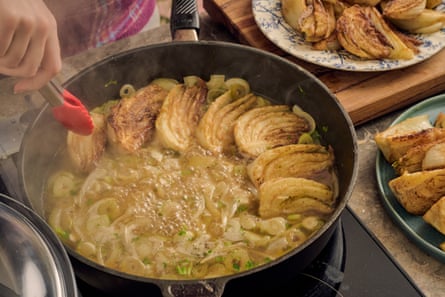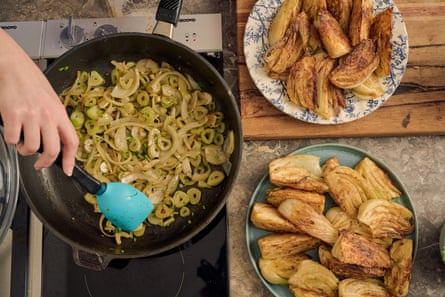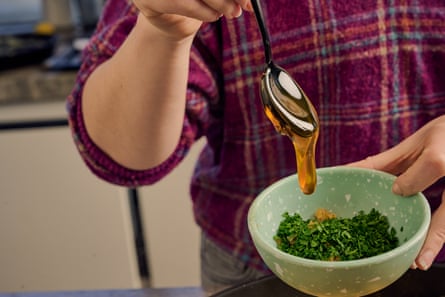
During winter our attentions and appetites turn to the cooking methods that can coat the kischkes (Yiddish for guts) – which means that it’s time for soups and braises to shine.
But while we often think of braises as meat-based dishes, you can also give the slow-and-steady treatment to vegetables with comparable kischke-coating results.
Braising is a gentle “wet” heat cooking technique – a low simmer with just enough liquid to come up the sides of the key ingredient. You’re trying to soften and impart flavour into the ingredients in the pot, as opposed to a stock or soup where you’re extracting flavour from the ingredients.
Meat-based braises or stews typically feature secondary, fibrous cuts of meat. As they simmer away at a low temperature for hours, the fibres break down and become beautifully fork-tender.
And you can apply the same principles to vegetables too. Think tough or fibrous veg which, like secondary cuts of meat, benefit from a slower, more gentle cook.
We’re talking woody root vegetables like parsnips and carrots, crunchy stalks like rhubarb or celery, and brawny bulbs like fennel. Best of all, vegetable braises – like today’s recipe – can work as hearty sides or hold their own as the main event.
One-pot simmery fennel and honey braise
Treat fennel like a three-in-one vegetable. The fronds can be used as a herb garnish, the stalks like celery in a mirepoix and the bulb as the juicy, sweet heart, chopped into chunky wedges for frying and gentle cooking.

In some meat-braise recipes, the protein is dusted in flour to prevent it from sticking to the pan and also to encourage the Maillard reaction which develops a brown, flavoursome crust.
I’ve co-opted this technique with the fennel, but the flour does a different trick – it helps thicken the sauce. Once the flour-coated fennel hits the hot butter and oil, the outside becomes toasty and biscuity and creates something like a cheat’s roux (the butter-and-flour combination used to thicken sauces such as bechamel).
In meat-based braises the combination of gelatinous meat, flour and a little oil is sufficient to thicken the stew. Here I’ve boosted the amount of olive oil for heat-cranking purposes and have added butter for flavour. The result is a vegetable dish with the same luscious viscosity of a meat braise. (I’ve used plain flour, but gluten-free plain flour works well too.)

A note about salt
The recipe uses two saline-y suspects: stock and preserved lemon. If using a store-bought stock, after adding it to the braise, taste the dish for seasoning before adding more salt as many commercial stocks contain ample amounts. As for preserved lemons, salt is what “preserves” the sunny yellow fruit- so they’re consequently quite salty. Scrape off the pith and flesh with a teaspoon as these can be bitter – it’s the peel you’re prizing here. Once the preserved lemon and honey mix is stirred through the braise, taste again, and then finish off your seasoning.

Serve this fennel braise on top of creamy polenta as a vegetarian main event, or alongside roast chicken or pork-and-fennel sausages as a silky, supple side dish.
Serves four to six
3-4 medium fennel bulbs (1.5kg total weight)
¼ cup plain flour (can be substituted with gluten-free plain flour)
Olive oil, for frying
100g salted butter
1 brown onion, finely sliced
½ bunch parsley, stems finely chopped, leaves roughly chopped (reserve some whole leaves for garnish)
2-3 cloves garlic, finely sliced
500ml vegetable or “chicken-style” stock
1 lemon
1 heaped tbsp preserved lemon, peel only (from about three cheeks, pith and flesh removed), finely chopped
1 tbsp mild-flavoured honey
Trim the tough, woody bases from the fennel, being careful to keep enough flesh at the bottom to hold the wedges together. Following the contour of the fennel bulb, trim away the fronds and stems. Place the lot – the trimmed bulbs, remnant bases, fronds and stems – into a bowl of cold water to rehydrate and dislodge any grit.
Cut each fennel bulb into eight wedges (this will vary depending on its size – you might get six wedges with smaller bulbs, and even 10 wedges for big mamas). To do this, slice the fennel bulb in half lengthways, then lie cut-side down and slice evenly at an angle, being careful to keep each wedge attached to the base if possible. Place flour in a shallow bowl and toss each fennel wedge in a light dusting.
Heat a Dutch oven or heavy-bottomed pan with a lid over a medium heat and add a good glug of olive oil to cover the surface of the pan. Add half the butter and let it sizzle and froth.
In batches, arrange fennel wedges, cut-side down, to cover the surface of the pan, and fry for five minutes on each side until lightly golden, trying not to move them around too much. Remove from the pan and set aside, then repeat with remaining fennel, adding more oil and the remaining butter as you go (be careful not to burn the base of the pan – lower the heat if necessary).
As the bulbs sizzle, finely slice the fennel stems into discs. When the fennel wedges have been removed from the pan, add the fennel stems and onion and sweat for eight minutes with the lid on, stirring occasionally until the onion turns translucent.
Add the garlic and the parsley stems and toss to combine. Pour in the stock, taste for seasoning, and add salt and pepper if necessary, then bring to the boil.
Add the golden fennel wedges, reduce the heat to low-medium, and simmer for 20 to 25 minutes with the lid on, stirring occasionally. The braising liquid will reduce, thicken and become lovely and glossy, and the fennel is ready when it becomes translucent and you can lop off the layers from the central stalk with a metal spoon.
Meanwhile, zest the lemon and squeeze the juice. In a small bowl, combine lemon zest and juice, chopped parsley leaves, preserved lemon and honey.
Remove the fennel braise from the heat. Add the lemon and honey mixture, and stir through the fennel braise to allow the flavours to get friendly. Taste for seasoning and add more salt and pepper if necessary. Serve garnished with fennel fronds and parsley leaves.



